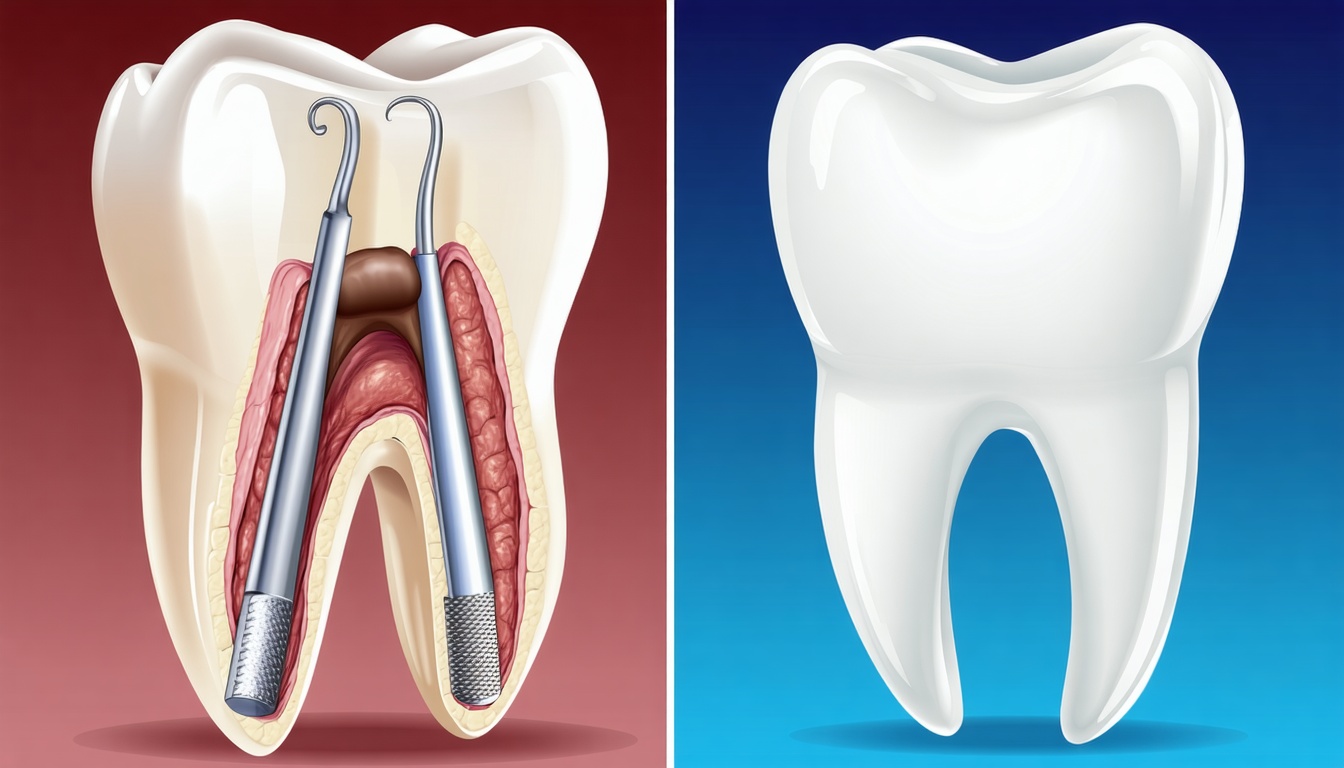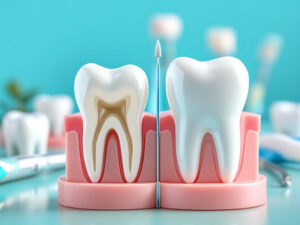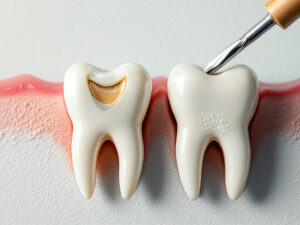Understanding Dental Procedures
When faced with dental issues, understanding the available procedures can help you make informed decisions about your oral health. Two common treatments are tooth extraction and root canal treatment. Each serves a unique purpose and is suited to different situations.
Tooth Extraction Overview
Tooth extraction is a procedure that involves removing a tooth from its socket in the maxillary or mandibular bone. This procedure can be performed by a general dentist, an oral surgeon, or a periodontist, depending on the complexity of the case (Mount Sinai Health Library).
There are various reasons for a tooth extraction, such as severe decay, infection, or overcrowded teeth. The procedure can provide immediate relief from dental pain, particularly if the tooth is broken or infected (Cleveland Clinic). While most patients can return to their normal activities within 48 to 72 hours, complete healing of the jawbone takes several weeks. Risks associated with the procedure include post-operative complications, underscoring the importance of discussing potential risks with your dentist before proceeding.
| Tooth Extraction Key Points | |
|---|---|
| Performed by | General dentists or oral surgeons |
| Recovery Time | 48 to 72 hours for normal activities |
| Complete Healing | Several weeks |
| Immediate Benefits | Pain relief from infected or broken teeth |
Root Canal Treatment Overview
Root canal treatment becomes necessary when the pulp—the soft tissue inside the tooth—becomes inflamed or infected. This condition can arise from various factors, including minor injuries that aren’t immediately apparent, such as chips or cracks. Left untreated, pulp infection can lead to severe pain or even an abscess (American Association of Endodontists).
The main objective of a root canal is to eliminate bacteria from the infected canals, prevent reinfection, and effectively save the natural tooth. This procedure is usually painless and can typically be completed in one or two appointments, depending on the tooth’s condition. Many patients find root canal treatments to be as routine as getting a filling, with most able to return to regular activities immediately, although you should avoid eating until any numbness has subsided (American Association of Endodontists).
| Root Canal Treatment Key Points | |
|---|---|
| Purpose | Save the natural tooth by treating infection |
| Procedure Duration | One or two appointments |
| Pain Level | Generally painless; comparable to a filling |
| Long-term Outcome | Successful treatments can last a lifetime (Cleveland Clinic) |
Understanding these two essential dental procedures will empower you to make educated choices regarding your dental health. Whether you are dealing with persistent tooth pain, sensitivity, or infection, knowing the basics of tooth extraction and root canal treatment can guide you toward the right solution for your situation. For more details about specific aspects of these treatments, check out what is a root canal or what is root canal treatment.
Reasons for Tooth Extraction
Tooth extraction is sometimes necessary to maintain your overall oral health. You may need to consider this option under several circumstances.
Tooth Decay
Severe tooth decay, also known as caries, occurs when bacteria erode the tooth structure, leading to cavities. If decay reaches the inner pulp of the tooth, it may cause infection or significant pain, making extraction a viable option. In such cases, a root canal treatment may not suffice, and extraction becomes essential.
Gum Disease
Gum disease, or periodontal disease, results from the accumulation of plaque and tartar along the gum line. Left untreated, this can lead to gum inflammation, infection, and ultimately tooth loss. When the tooth is compromised due to advanced gum disease, it may require extraction to prevent further health issues (Mount Sinai Health Library).
Overcrowded Teeth
Overcrowding often occurs due to the lack of space in the mouth for all teeth to fit properly. This situation can affect alignment, hygiene, and overall dental health. Your dentist may recommend extraction as part of a comprehensive orthodontic treatment plan to create space and facilitate proper alignment.
Impacted Teeth
Impacted teeth are those that cannot fully emerge through the gums, commonly seen with wisdom teeth. Impacted teeth can lead to pain, swelling, and infection. Extraction may be necessary to alleviate symptoms and prevent complications.
Tooth Breakage
If a tooth is significantly broken or fractured due to trauma, it may not be repairable. In such cases, extraction is often the best option to eliminate pain and prevent potential infection. You should consult with your dentist to explore available options, including root canal therapy if applicable (Oral & Facial Surgeons of Arizona).
If you are experiencing symptoms such as persistent tooth pain or sensitivity, consider consulting a dental professional who can guide you through options like extraction versus preservation methods, such as what is a root canal or evaluating your treatment options based on the health of your teeth.
Reasons for Root Canal Treatment
When faced with persistent tooth pain, sensitivity, or infection, understanding the reasons for root canal treatment can help you make informed decisions about your dental care. Here are the primary reasons why you might need a root canal.
Pulp Inflammation or Infection
Root canal treatment is necessary when the pulp, the soft tissue inside the root canal, becomes inflamed or infected. This can occur due to various factors, such as injury to a tooth, even without visible chips or cracks. If left untreated, pulp inflammation or infection can lead to severe pain or result in an abscess. More details can be found in our article on what is a root canal.
Tooth Sensitivity
You may require a root canal if you experience heightened sensitivity in a tooth, particularly to hot or cold sensations. This often results from issues like a cracked tooth from an injury or deep decay. In some cases, problems from a previous filling can also contribute to the need for treatment. For more information on symptoms, refer to our guide on signs you need a root canal.
Deep Decay
Deep decay is a common reason for root canal treatment. When significant decay progresses into the pulp, it can lead to inflammation or infection. Without intervention, this condition can exacerbate, causing pain and potentially leading to an abscess. You can learn more about the details of root canal treatment in our article on what is root canal treatment.
Previous Dental Procedures
If you have undergone multiple dental procedures on a single tooth, you may be at risk for pulp-related issues. Repeat fillings, crowns, or other treatments can cause stress on the tooth and increase the likelihood of pulp damage. A root canal can help preserve the tooth and reduce the need for ongoing dental work. For insights on root canal success and longevity, read our piece on is a root canal worth it.
Faulty Crowns
Faulty crowns can lead to pulp irritation and infection. If a crown does not fit properly or becomes damaged, it can contribute to decay and subsequently affect the underlying pulp. In this case, root canal treatment becomes necessary to save the tooth. To understand more about the implications of crowns and their relation to root canals, please visit our root canal FAQ.
When considering dental options, weigh the benefits of root canal treatment against tooth extraction. By addressing these conditions promptly, you can aid in preserving your natural teeth and maintaining your long-term oral health.
Benefits of Tooth Extraction
Tooth extraction may seem intimidating, but it offers several key benefits, particularly for those dealing with severe dental problems. Understanding these advantages can help you make an informed decision when weighing options like root canal vs tooth extraction.
Bacteria Reduction
One significant advantage of tooth extraction is the reduction of harmful bacteria that can damage your teeth and gums. A decayed or damaged tooth can harbor bacteria, leading to infection and further complications if left untreated. By removing the affected tooth, you can significantly improve your long-term oral health (Cleveland Clinic).
| Benefits | Description |
|---|---|
| Bacteria Reduction | Removes the source of harmful bacteria |
| Long-term Oral Health | Allows for better management of oral conditions |
Immediate Pain Relief
If you’re experiencing severe pain due to a broken or infected tooth, extraction can provide immediate relief. The procedure removes the source of discomfort, allowing you to feel better almost instantly. Many people find that their pain significantly decreases following the extraction.
| Benefits | Description |
|---|---|
| Quick Pain Relief | Pain alleviated almost immediately after extraction |
| Improved Comfort | Enables a more comfortable daily routine |
Recovery Process
The recovery process following a tooth extraction typically takes several days, with most individuals returning to their routine activities within 48 to 72 hours. Complete healing of the jawbone may take several weeks, especially for larger teeth like molars. It’s essential to follow proper aftercare guidelines to promote healing and monitor for any signs of infection (Cleveland Clinic).
| Recovery Timeline | Duration |
|---|---|
| Normal Activity | 48 – 72 hours |
| Complete Healing | Several weeks to months |
Understanding the benefits of tooth extraction can assist you in discussing your options with your dentist. If you find yourself considering extraction, ensure you weigh these benefits against alternatives like root canal treatment, which may offer other advantages such as preserving the natural tooth structure. For more details on root canal options, you can refer to our articles on what is root canal treatment and signs you need a root canal.
Benefits of Root Canal Treatment
Root canal treatment has several benefits that can significantly improve your dental health and quality of life. Understanding these advantages can help you make an informed decision when considering your options for pain relief and tooth preservation, especially when weighing the options of root canal vs tooth extraction.
Tooth Preservation
One of the primary benefits of a root canal is the preservation of your natural tooth. This procedure is designed to eliminate bacteria from the infected root canal, prevent reinfection, and ultimately save the tooth. Millions of teeth are treated successfully each year through root canals, ensuring that patients maintain their natural smile.
Choosing a root canal means you can sustain your normal eating habits, avoid changes in your speech, and maintain the spacing of other teeth in your mouth. The health of your jawbone is also supported, as preserving your natural tooth helps prevent bone loss.
Pain Elimination
Root canal treatment is not just about preserving teeth; it’s also a solution for alleviating discomfort. This procedure effectively addresses the main cause of tooth pain, which could stem from pulp inflammation or infection. By removing the infected tissue, you can experience almost immediate relief from a wide range of symptoms, including sensitivity to hot and cold and persistent pain. The relief from pain can enhance your overall well-being and restore your ability to eat or drink comfortably (VDC Dental Alaska).
Recovery Process
The recovery process after a root canal is typically quick and straightforward. Many patients can return to their normal activities shortly after the procedure. Depending on the condition of your tooth, root canal treatment can usually be completed in one to two visits (American Association of Endodontists).
Post-treatment discomfort can often be managed with over-the-counter pain relief methods, and it’s essential to follow any aftercare instructions provided by your dentist. Maintaining proper dental hygiene during the recovery phase can help ensure your tooth heals effectively, preventing complications.
For more detailed information, including the steps involved in the treatment, you can refer to articles on root canal procedure steps and root canal recovery time. Additionally, if you’re looking for pain relief tips specific to root canals, visit our page on root canal pain relief tips.
Root canal treatment offers significant benefits, focusing on preserving your natural teeth while relieving pain and ensuring a relatively smooth recovery. These factors make it a valuable option when facing dental health challenges.
Root Canal vs Tooth Extraction
Deciding between a root canal and tooth extraction involves understanding the procedures, costs, and considerations for future tooth restoration. This section will help you navigate the differences.
Procedure Comparison
Both procedures aim to address dental issues but involve distinct steps and outcomes. A root canal entails removing the diseased pulp from inside the tooth, followed by cleaning, disinfecting, filling, and sealing it. This process preserves the tooth structure while eliminating infection. In contrast, tooth extraction involves removing the entire tooth from the socket, which leaves a gap that may require restoration.
| Procedure | Steps Involved | Outcome |
|---|---|---|
| Root Canal | Remove pulp, clean, fill, seal | Preserves natural tooth |
| Tooth Extraction | Extract the entire tooth from the socket | Gap may require restoration |
You may find that a root canal procedure is generally no more painful than having a filling and helps maintain natural tooth spacing, which is important for long-term dental health (VDC Dental Alaska).
Cost Comparison
When considering finances, the costs of root canals and tooth extractions can vary. In many cases, opting for a root canal could be less expensive and more beneficial for preserving your natural tooth structure.
| Procedure | Average Cost |
|---|---|
| Root Canal | $700 – $1,500 |
| Tooth Extraction | $75 – $300 |
Choosing a root canal tends to save money in the long run due to the costs of future dental work if an extraction leaves a gap. These costs often include bridges, implants, or dentures to restore lost teeth, adding to overall expenses.
Considerations for Tooth Restoration
When you undergo one of these procedures, it’s essential to consider the long-term impacts on your dental health. A root canal can help to maintain the original tooth, preventing future issues related to spacing, bite alignment, and jawbone health. Aside from maintaining aesthetics, this option supports ongoing oral functionality.
- Portraying natural look and function
- Preventing bone loss around the area where the tooth was located
In contrast, tooth extraction may lead to a need for further restorative work, as leaving a gap can affect your smile and how you chew. It can also result in shifting teeth, which negatively impacts oral health over time.
Understanding the implications of each choice can inform your decision-making process regarding treatment for your dental discomfort. For questions on the specifics of the procedures, consider checking out our sections on what is root canal treatment, root canal procedure steps, and signs you need a root canal.










